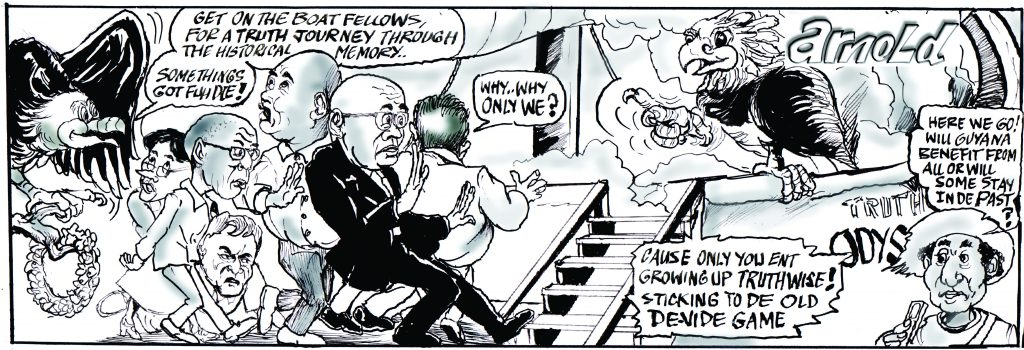IN 2004, Eusi Kwayana had an essay published in the Sunday Stabroek, September 5 Edition. It was titled “We need a nation conversation” and it should be revisited and explored. Eusi by far has had profound experiences in the fragmented suddenness of the Guyanese identity, with impulses and interpretations from what I have witnessed, experienced and known and though we live in the same age, say encompassing three generations. Yet, in the context of his essay, though I understand, and culturally do empathise and laud the work done by him and his comrades, that conversation cannot happen unless we face the preliminary challenges of an Odyssey into the historical mind and the specific currents that direct its nature.
That Odyssey must begin with an attack on the peripheral propaganda ‘Trojan’ horses that have been allowed to exist and poison minds and create mirages in the imagination without challenge for too long. These contorted events must be identified, as they remain unaddressed, with supporting narratives from endorsing forces that have aided and quietly condoned and supported these peripheral Harpies and their Siren melodies that offend, tempt and consume the targeted mass into self-hating submission. I should illustrate what I mean by presenting an example of what I wish to be understood. Almost two years ago, with a company of my peers, we visited an important stakeholder group; it was wrongly agreed that we would not engage in exchanges, but would take the postures as ‘sacrificial sheep’ and listen to what is said. Regardless, without rebuttal, this was against my nature, and I still regret it, but my word is my word. This event is etched in my mind, so I know the month was May, possibly days before our Independence Jubilee. When a prominent member of that group expounded on the insult of May as the independence date when the Linden massacre had forced ‘the people’ away from their homes…and he continued with his loud one-sided diatribe. None of his colleagues interrupted, their body language was of agreement and with the few whose group he was subliminally referring to, seemed speechless and immobilised as the tirade continued and concluded. This was an example of the mirages that are active, and like the craft of the magician are spoken into ectoplasm life.
The dangerous response is to feign and avoid confrontation in the hope that it will dissipate as people move on. Instead of like a Hollywood movie Delilah, she serves her romantic emotional purpose, rather than as the biblical narrative reports, she commits her treachery, then just disappears, nothing more was said about her, but the movie lie of Delilah (justified at the ticket returns) becomes the emotional substance of a heroine. In fact, it is the public’s fault that it does not separate the two. Fact is, in the Guyana context, there was no Wismar massacre, there were arsons and evictions and ugly things, in an ugly time that happened there as a result of horrible things that happened elsewhere.
After independence, Prime Minister Burnham gave those citizens lands for resettlement on the East Coast. The inquest into the Wismar, Christianburg and Mackenzie disturbances was headed by Chairman-Magistrate Sohan Roopan Singh. The problems were generated in the first instance by the murder and mutilation of the Sealeys at Buxton, on May 21, 1964 and in the second instance on June 6, 1964, by the bombing of the launch ‘Sun Chapman,’ in which 38 to 47 men, women and children perished from one group of Guyanese, all evidence led to others. In the end, the official conclusion was words to the effect that there was no ‘blood lust’ when considering the population by the ethnic majority and minority, total retaliation deaths were less than 10 persons. There are imbalances like the cited case that are callously entered into historical events to mainly serve political egos and the emotional impulses of victimhood with its array of dangerous pretensions.
There are other inquests like that of the Sun Chapman and the Abraham family arson murder that need to be placed in their relevant historical context. This is what a ‘Heritage Commission’ should house among its itemised human detailed research and pictorial political and social display formats, as an effective support asset to the National Archives, and more so, culturally, to filmmakers and publishers of the now and near future; to this effect, an intense collaboration with the Colonial Office in London and private entities and persons in possession of documents and imagery connected to the Guyanese identity will have to be pursued. The deeper historical and cultural disparities that manifest from the perspectives of separate interpretations of ‘world view’ practices that are summoned at times by innate expressions; whether brought as teachings from the old countries or cultivated here by colonial manipulation, are what present the most serious triggers for potential retreat into cultural/philosophical groups with the propensity for confrontations and social hostilities. Take for instance, ‘The Bribe’ in some cultures within the historical memory, this, if proven, is punished by death, while among others it is a common practice to seek to bribe even a ‘blessing’ and the outcome is all that is important, no moral guidelines impact on anything, only contrived postulations. This when identified summons resentment from both sides which are as deep-seated as any tribal, ethnic or religious animosity, upon this context emerges the bitter stereotypes and closedmindedness.
To the credit of the APNU+AFC administration, the Ministry of Social Cohesion has done sensitive and important work. I have witnessed this, but the divisive politics had no doubt recognised the neutralising effects of open discussions on separate ethnic definitions of each other. Explored in a workshop with Guyanese of diverse origins and geographic cultural roots, thus sadly, this programme was not supported by the opposition.
What those workshops presented and achieved as a witness, is a desire to know more from its participants about each other, who had never experienced that kind of exchange before. The serious threshold data has been presented in books, articles, journals, essays, even letters, but remain elusive to researchers from diverse disciplines, because of the lack of centralised topic cataloguing and a national reservoir of relevant literature. But from what has begun will inevitably lead to the further desire towards the more complex Odyssey into the historical memory, the real and imagined landscape and its denizens, with a conclusion of enlightenment, with a lessening of fictional biases.



.jpg)









